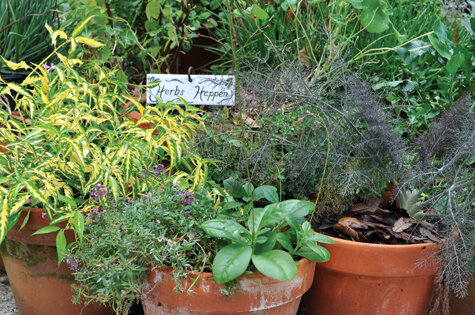The Potted Herb
by Tom Hewitt
I probably have more books on growing herbs than on anything else. Although they may have helped me in the beginning, there is simply no substitute for personal experience when it comes to growing herbs in Florida.
People grow herbs for many different reasons. I grow them mainly for making potpourris, teas and cookies. But I also grow them just for the pleasure of rubbing their leaves between my fingers and releasing their fragrance. Some, like chamomile, lemon marigold and calendulas, are worth growing just for their flowers.
I love bunching pots of herbs on the patio to create mini herb gardens. Photo by Tom Hewitt
Since most herbs need at least six hours of sun, I grow mine in pots on the patio. I use clay pots almost exclusively for this. I love the look and feel of terra cotta, and treasure my pots even more as they age. In fact, when I need replacements I visit a thrift shop a few blocks away and buy used ones.
Romance aside, terra cotta pots are naturals for accommodating herbs. They breath better than most other materials, and drain readily. To be honest, two of my largest containers are cement. But I painted them terra cotta years ago and no one can tell the difference.
I don’t bother with pots less than 8 inches deep or 10 inches across. Our growing seasons are long, and small pots dry out quickly. I reserve smaller ones for heat-loving Mediterranean herbs like oregano, sage and thyme. Since every square inch is needed for root growth, I don’t bother putting stones or shards in the bottom for drainage. I simply use coffee filters for round pots and paper towels for oblong containers.
Most perennial herbs, even those that are short-lived, need their own pot. These include tansy, garlic chives, lemon balm, parsley, catmint, Mexican mint marigold, Cuban oregano, tilo and a host of others. My favorite exception is rosemary, which grows slowly and will happily share quarters with other Mediterranean herbs for months on end.
Thyme, sage and marjoram are compatible, though a tight fit in this container. Photo by Tom Hewitt
In time, however, even rosemary will need its own pot, as will any of the mints. Some perennials, like fennel and rue, need their own space not only because they live so long, but also because they exhibit allelopathic properties that inhibit the growth of neighboring plants. Rue in particular needs good drainage to survive here in south Florida. It can irritate the skin, so use gloves when working with it.
When combining herbs, I usually limit three to a 16-inch pot, making sure their cultural requirements and growth rates are compatible. After assembling combos in the fall, I always tuck in a few nasturtium seeds. Alyssum and lobelia are also good companions for cool-season herb combos, and Dahlberg daisies work great for summer.
Though it’s true that herbs are not particularly fussy about soil fertility (most actually produce more essential oils when grown in poorer soils), any medium you use should remain friable (loose and easy to work), and drain well. I make my own mix by combining two parts potting mix (not potting soil) to one part compost and one part regular garden soil.
Rosemary, thyme and ‘Compacta’ oregano make a pretty, long-lasting combo. Photo by Tom Hewitt
Most people lose more herbs to over-watering than anything else. I let them wilt during the day (a natural response to the heat), and then water them the next morning if they haven’t rehydrated overnight. As plants grow and their roots fill their pots, they’ll need more frequent watering. That’s why it’s so important to choose the right size pot to begin with.
Herbs are not heavy feeders. Too much nitrogen can cause them to grow too fast and not be as flavorful. In fact, I usually give them time-release fertilizer when I plant them and let them be. A liquid feed at half strength can be used when necessary, but I only do this if plants start looking chlorotic (pale).
Growing herbs in pots has numerous advantages. As summer approaches, I can move my pots of tilo, culantro, lavender and other tender herbs into the shade. I’ve found that even nasturtiums will last a month longer if I put them in light shade. Lastly, I like to mulch all my potted herbs with oak leaves to cool their roots, add organic matter and conserve moisture.
Terra cotta strawberry jars (provided they’re big enough), work great for planting a pretty assortment of thyme. If you want more eye appeal in herb combos, consider using more ornamental varieties of common herbs, like variegated tilo, ginger mint, golden, tricolor or purple sage, or ‘Compacta’ oregano.
I love my potted herbs. I like bunching them on the patio to create an instant herb garden, and placing them in the butterfly garden when they bloom. Some folks might disagree, but I think my old chipped pots filled with herbs are some of the loveliest things in my garden.
Attractive Herb Combos
Use a minimum 16-inch pot for combos, and make sure you combine herbs with similar cultural requirements and growth rates. Use one tall plant, one rounded plant and one that cascades. Remember to harvest leaves and pinch back often to keep plants compact.
Rosemary, thyme and ‘Compacta’ oregano
Lavender, lavender thyme and purple sage
‘Tricolor’ sage, thyme and marjoram
Thai basil, parsley and variegated oregano
Pineapple sage, ‘Golden’ sage and lemon thyme
(succulent combo) Bulbine, aloe vera and Vick’s salve plant (Plectranthus tomentosa)
© 2014 Tom Hewitt. Originally published in Florida Gardening, Oct / Nov 2014. Reprinted by permission. All rights reserved.


